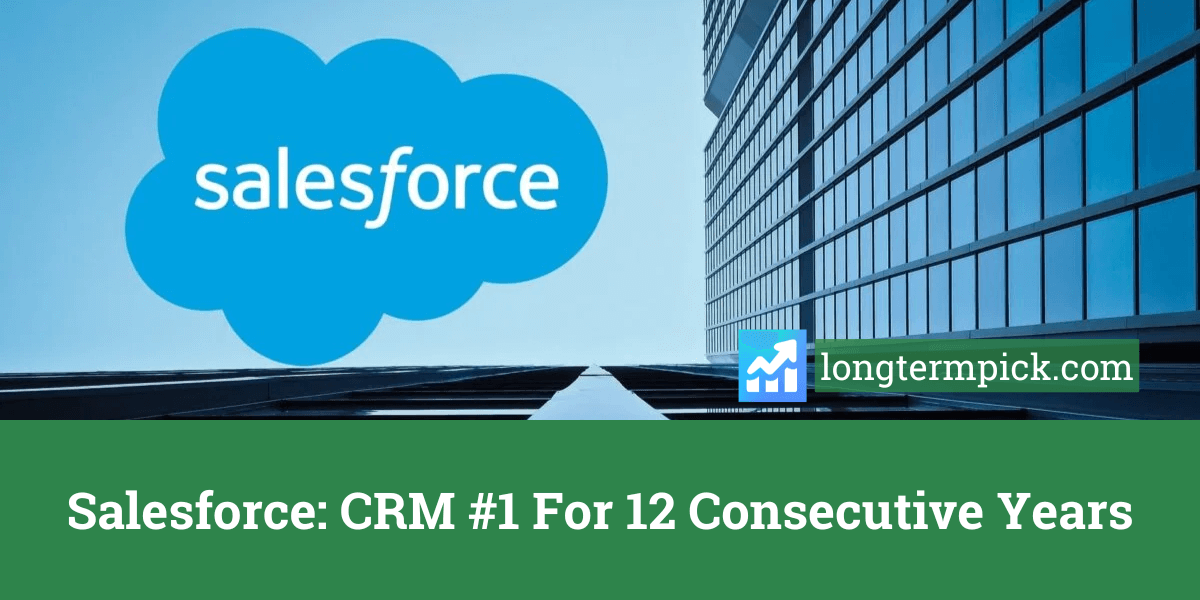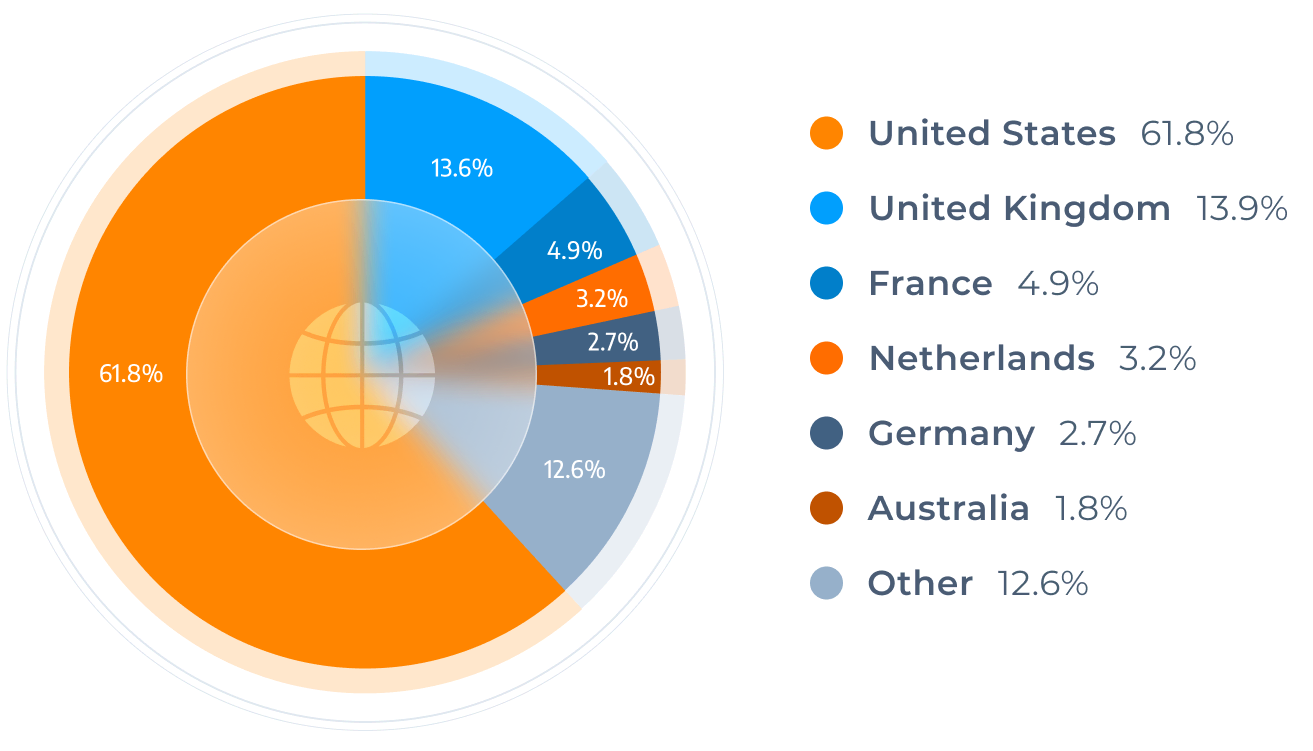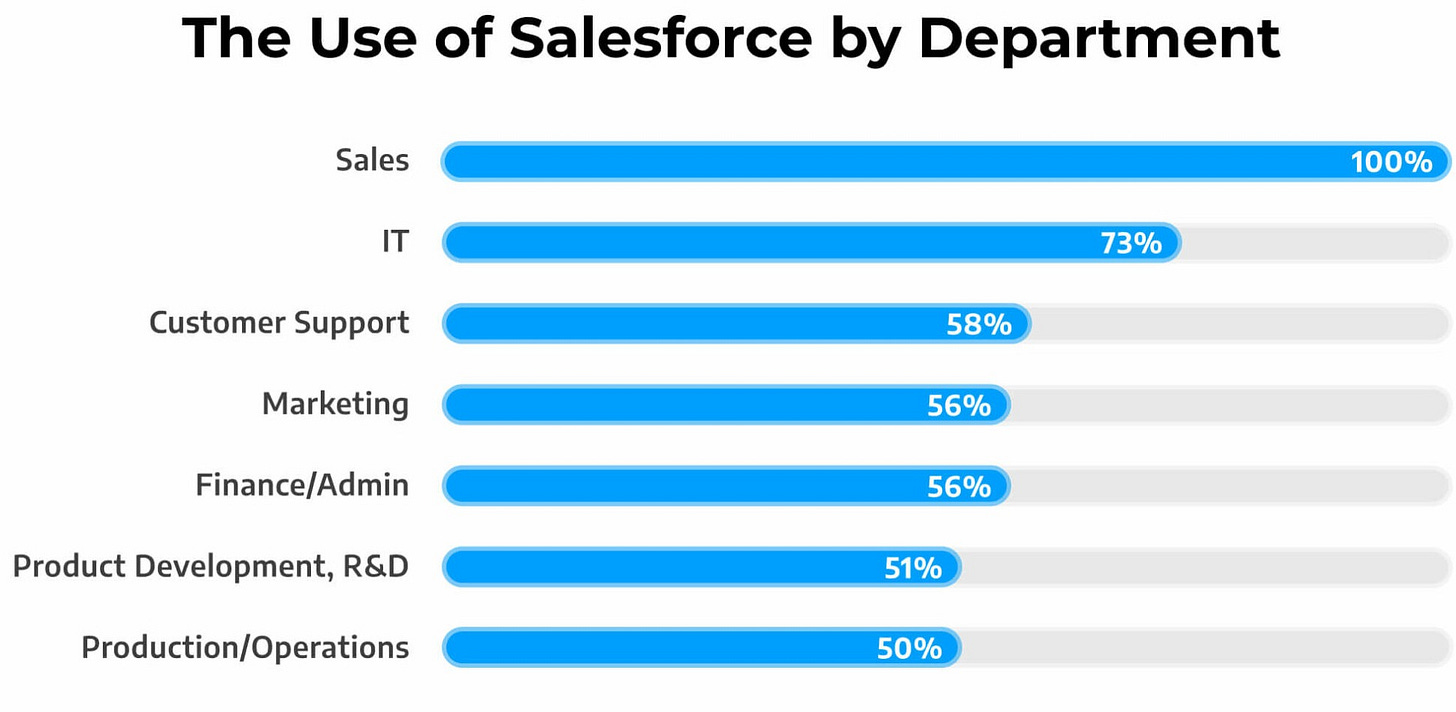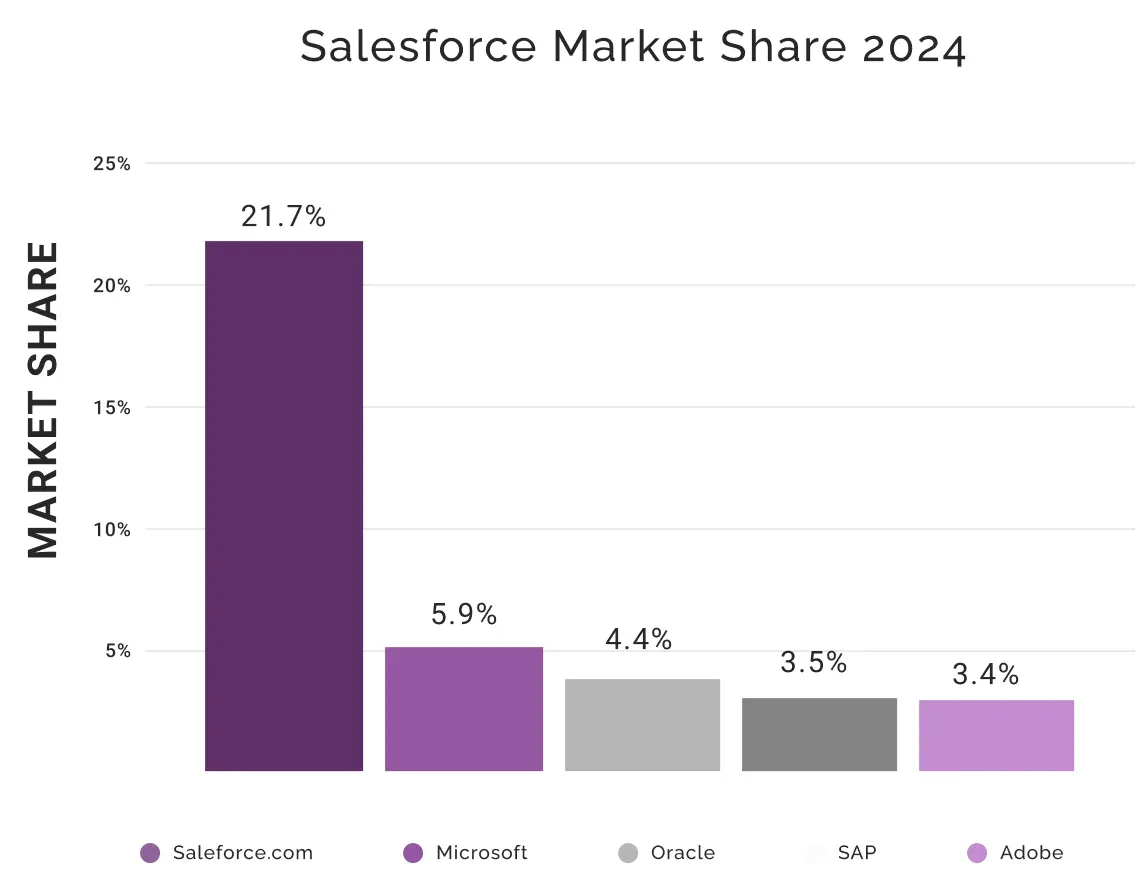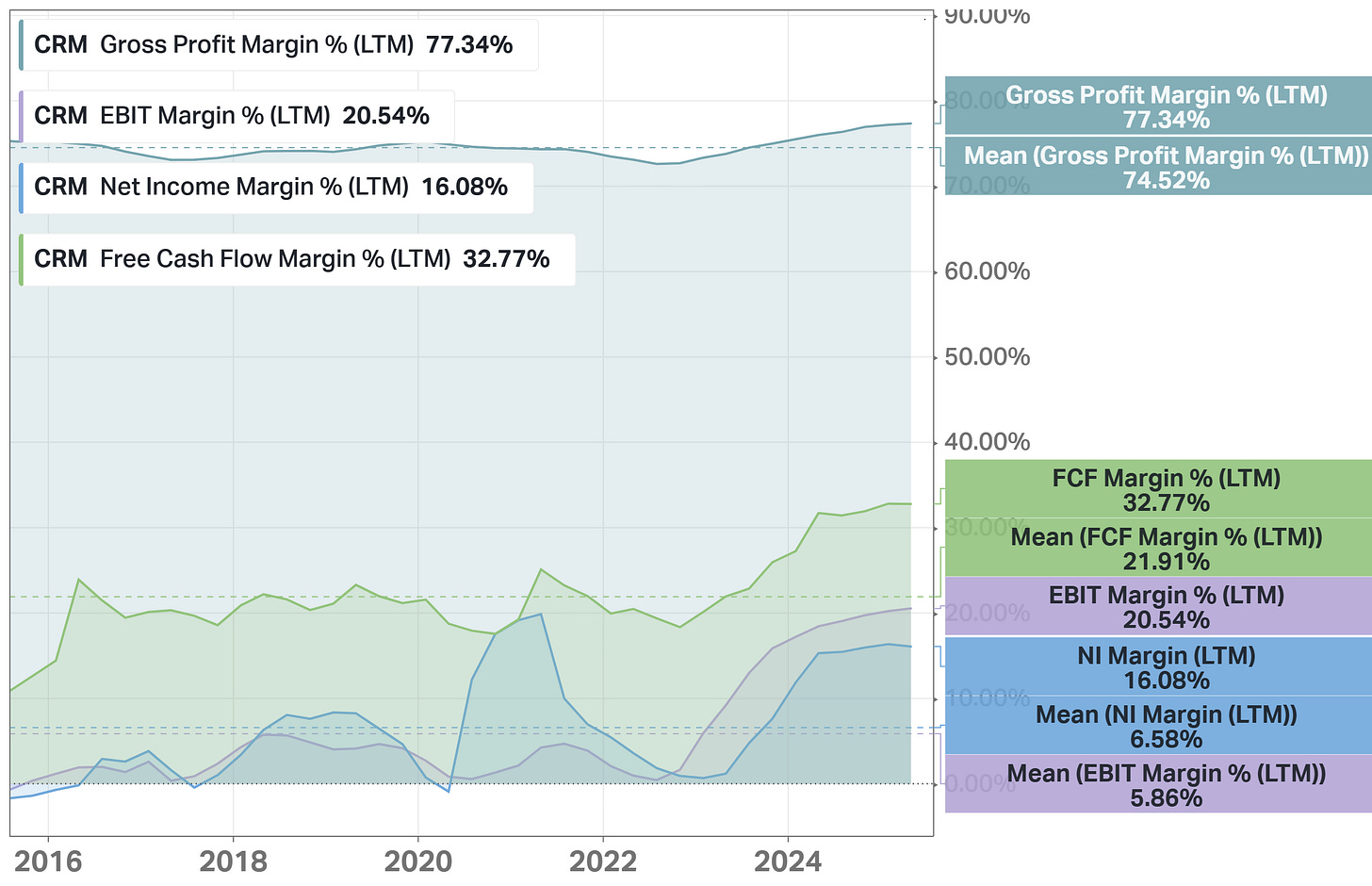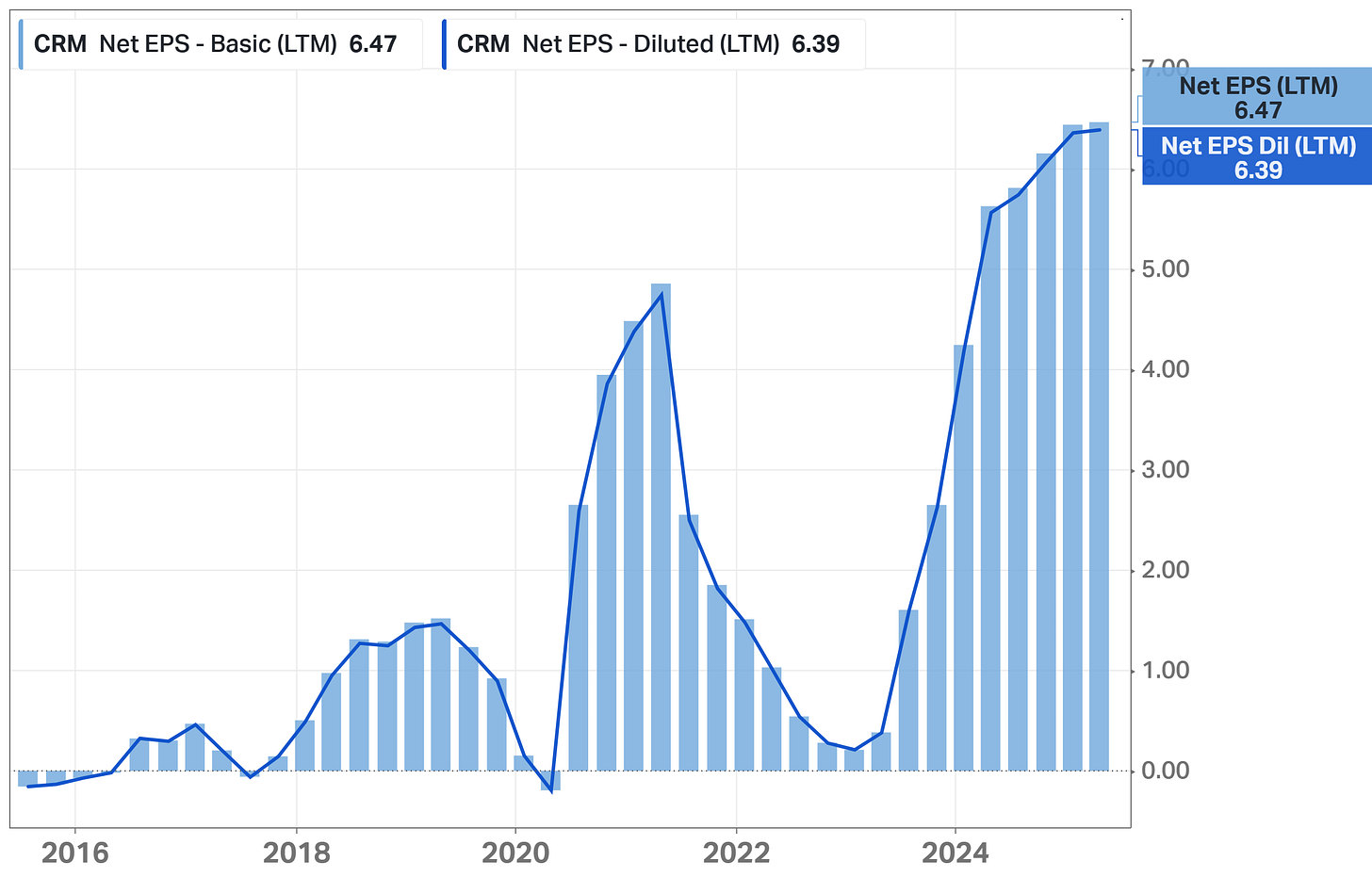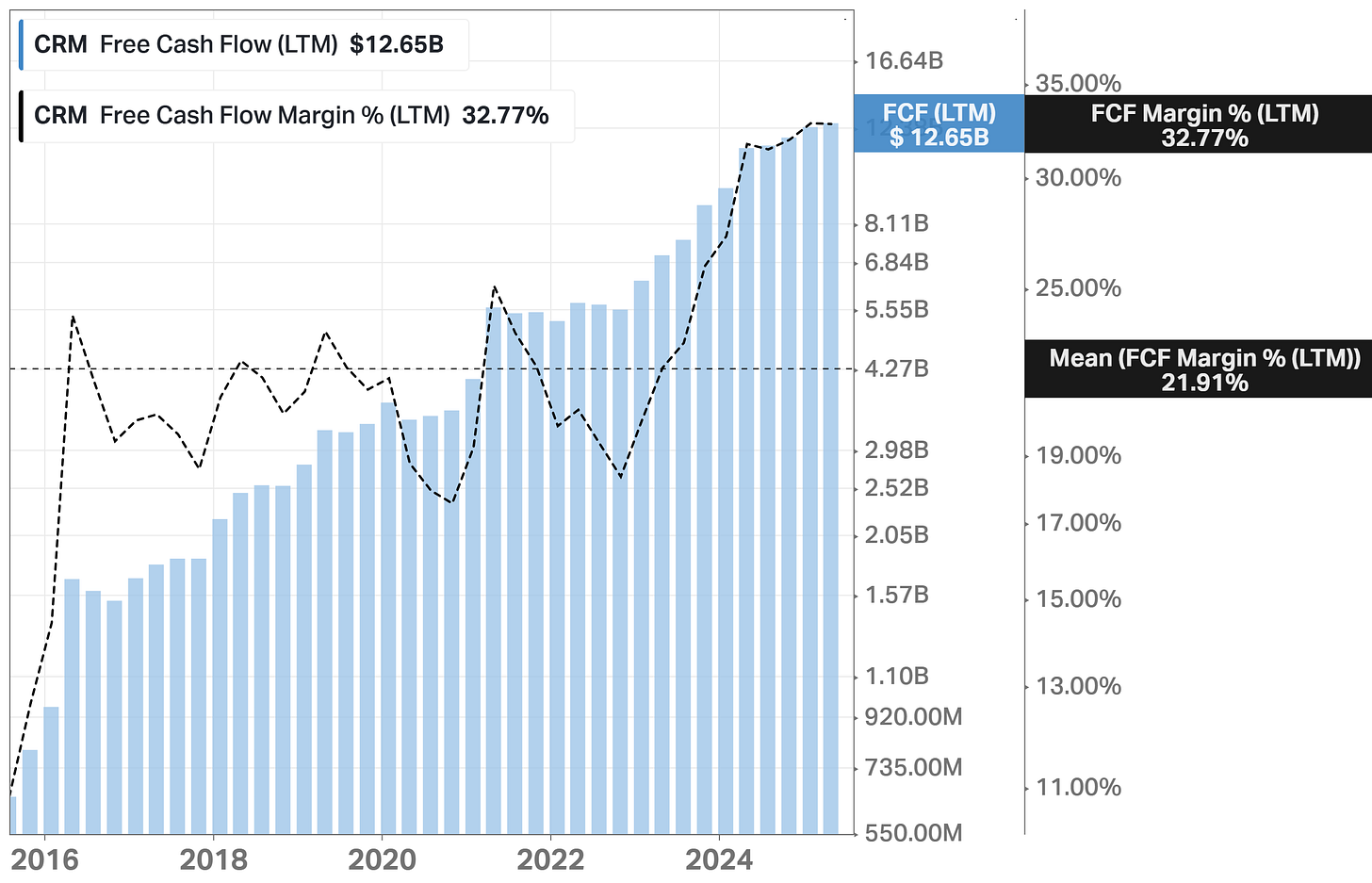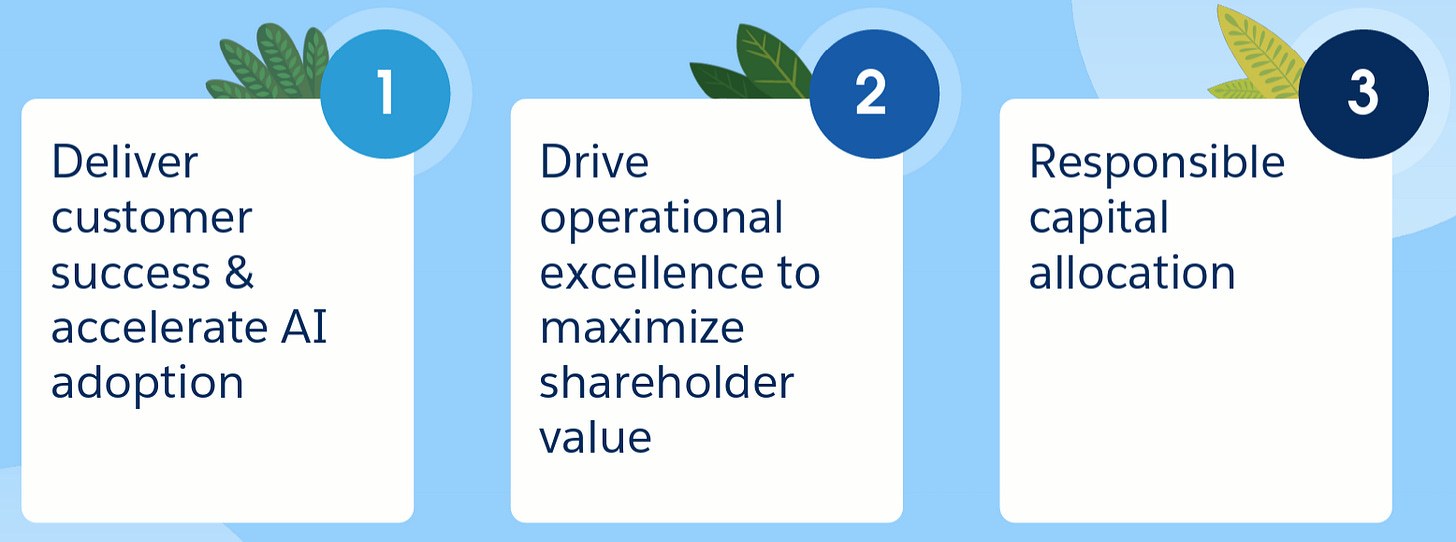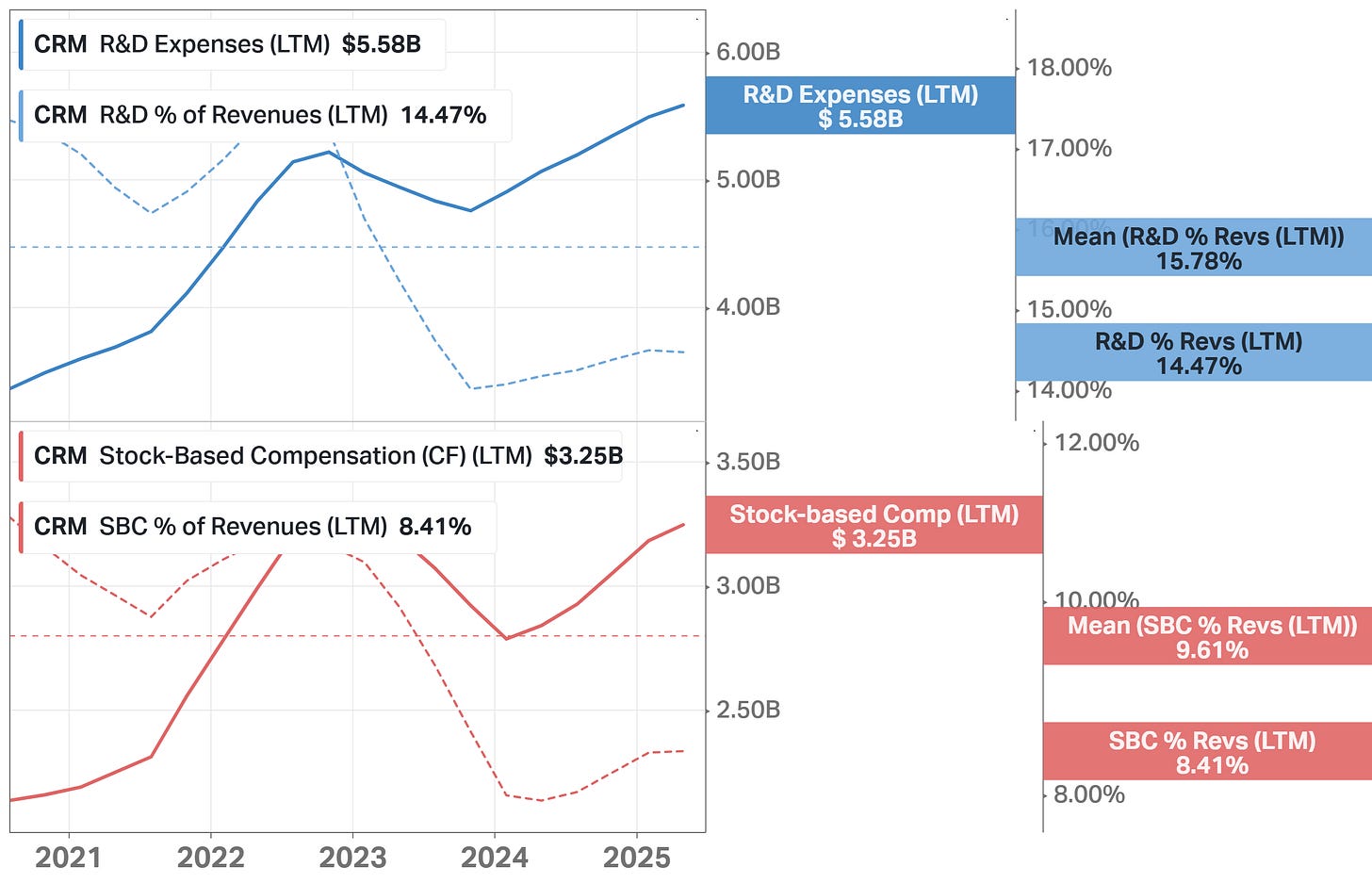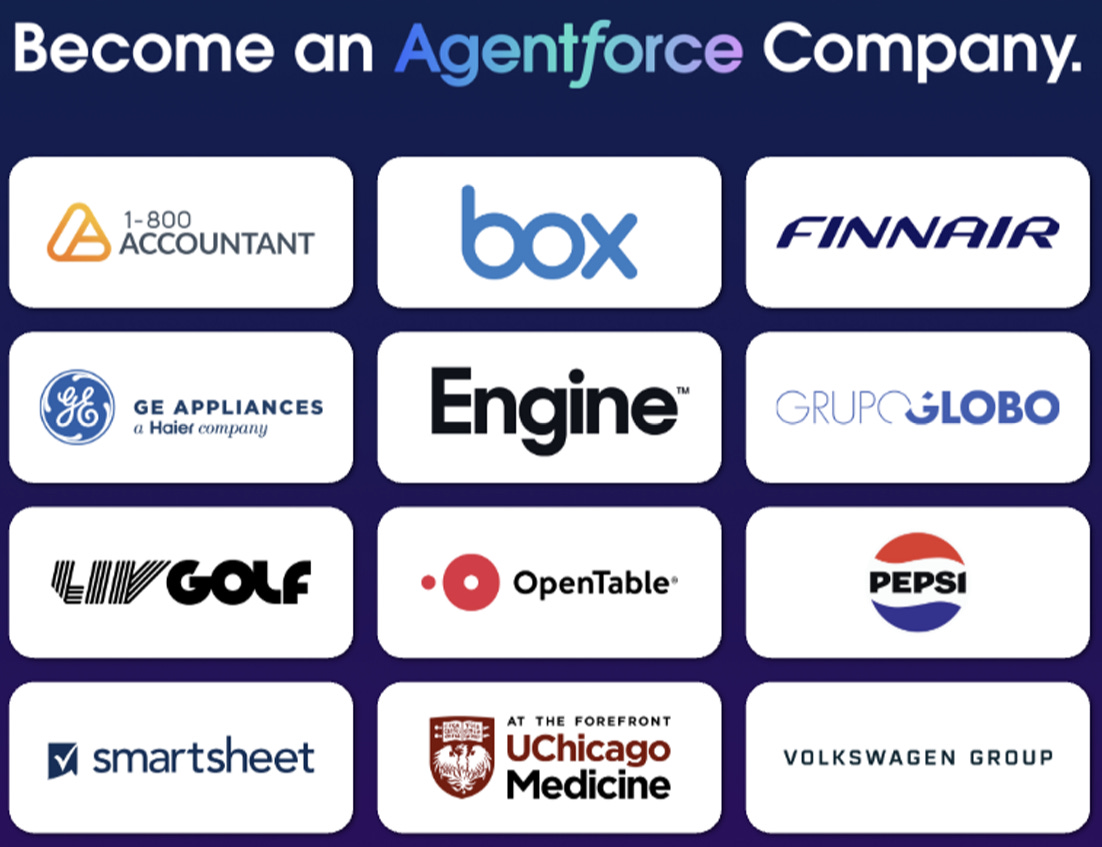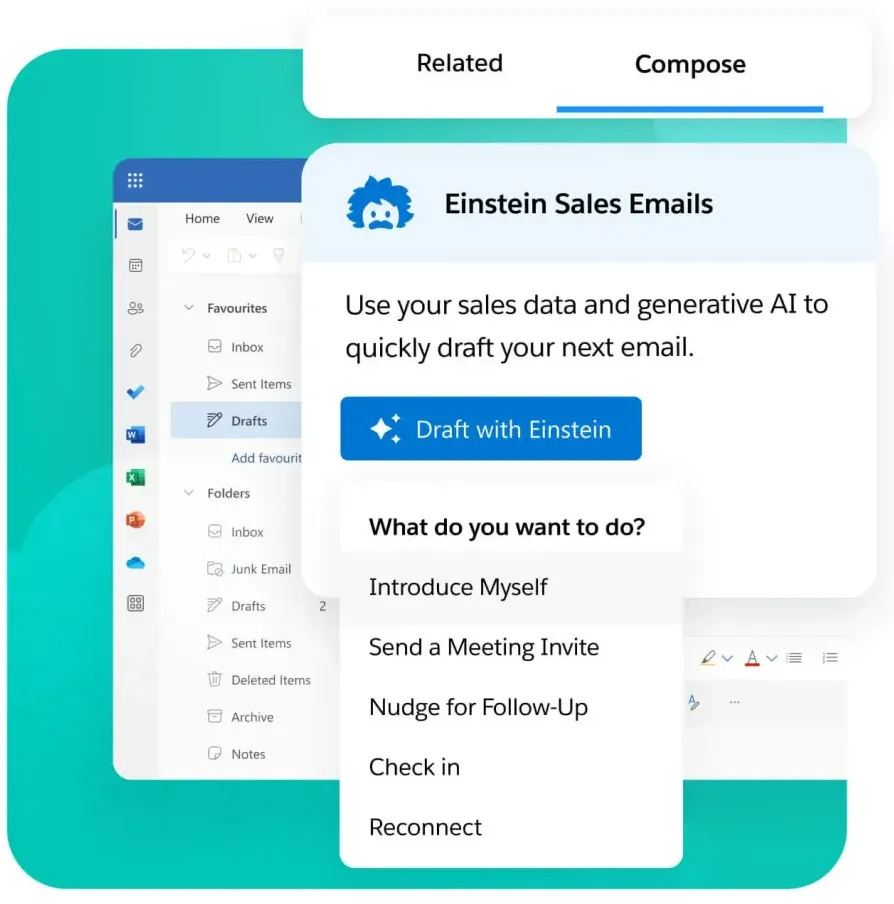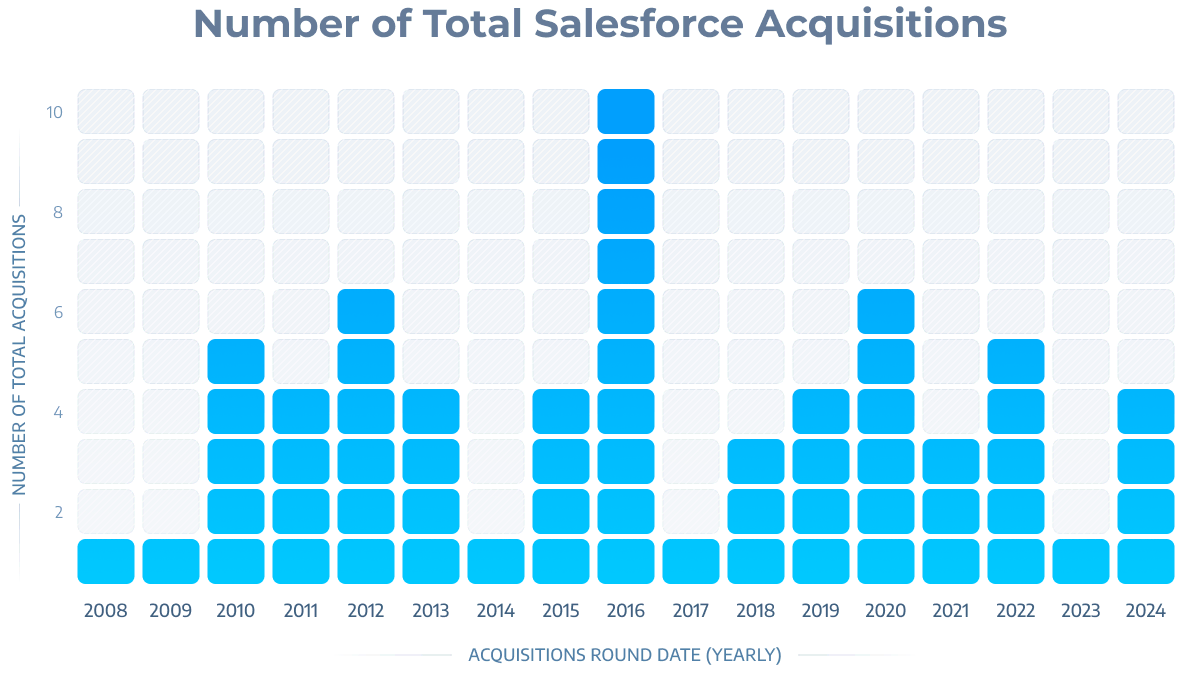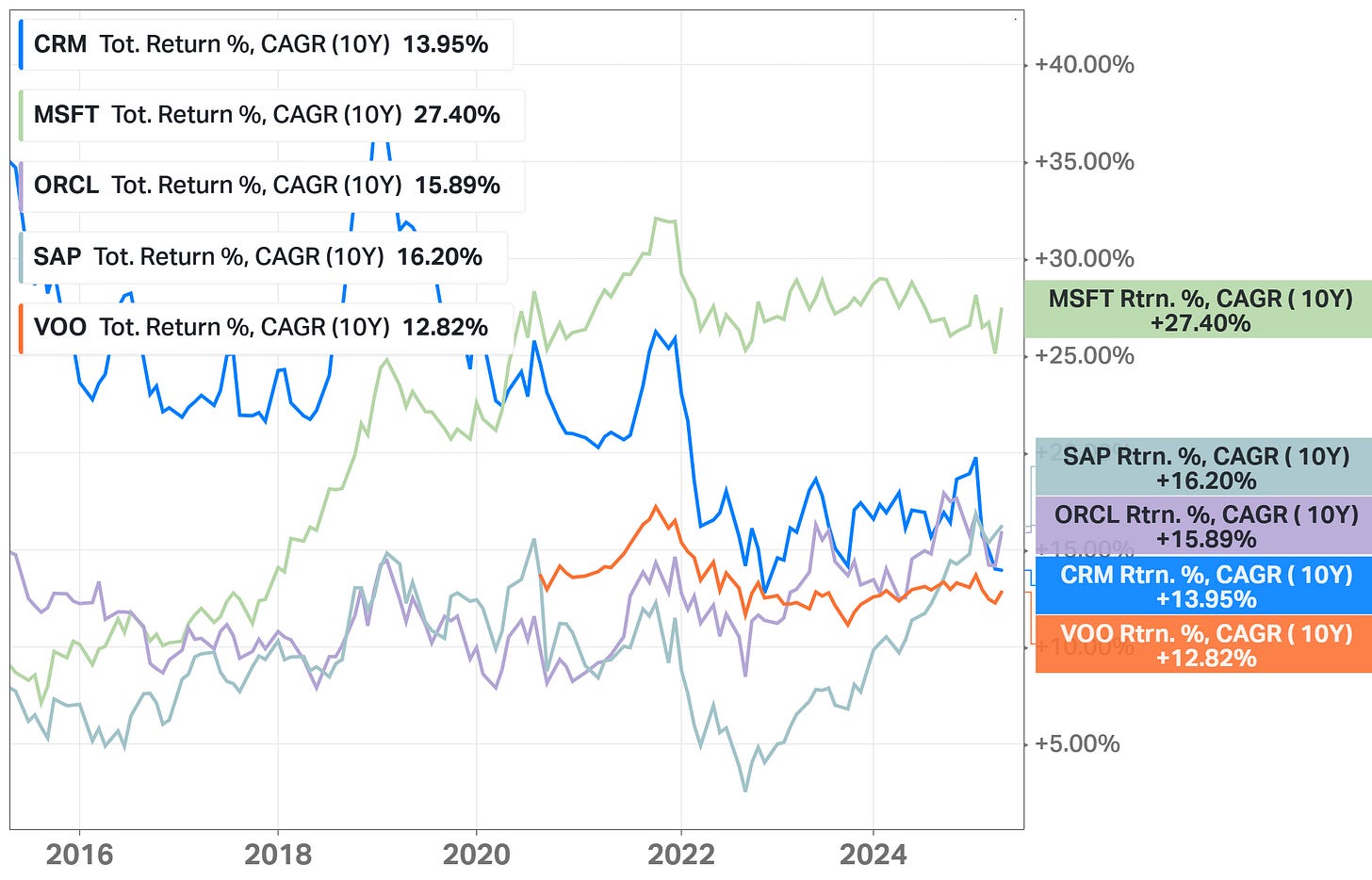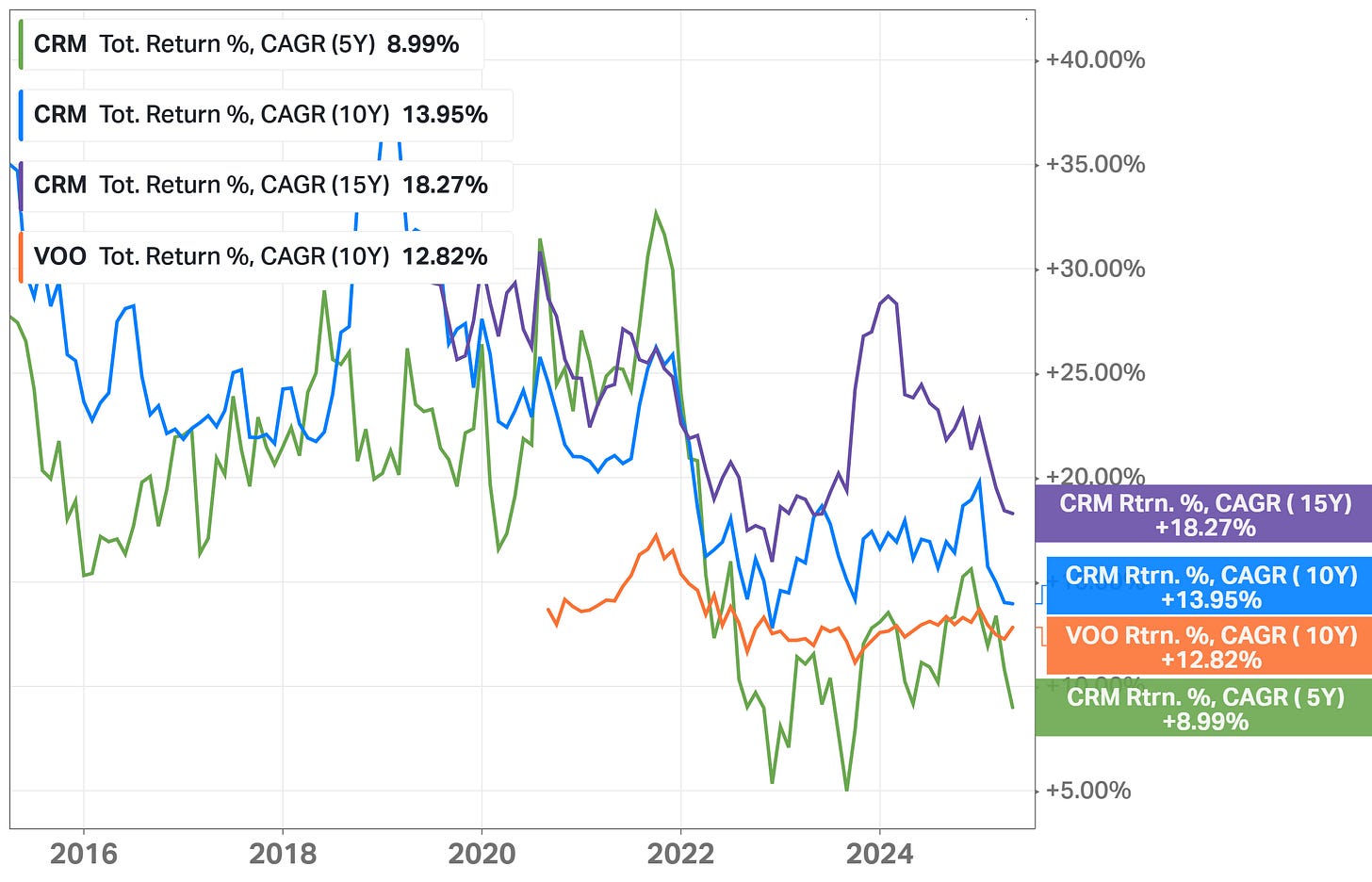Content:
• Company Overview
• Market Overview
• Economic Moat
• Business Strategy
• Capital Allocation
• Advantages
• Disadvantages
• Competitors
• Past
• Future
• Current Valuation
• Fair Price
• Checklist
• Due Diligence
• Investment Thesis
Company Overview
Market Cap: ~$264.84B
Sector: Technology
Industry: Software
Type: Large Core
Total Number of Employees: ~76,453
Next earnings report: Aug 27, 2025 (estimated)
Total Debt: $11.37B
Cash & Investments: $17.41B
Beta: 1.35
Website: www.salesforce.com
Salesforce (NYSE: CRM) is the world’s largest provider of customer relationship management (CRM) software with over 150,000 customers worldwide. Headquartered in San Francisco and founded in 1999, the company is led by CEO Marc Benioff, a pioneer of the software-as-a-service (SaaS) business model.
Salesforce helps businesses improve how they manage sales, service, marketing, and commerce by offering cloud-based software. These services allow customers to access their tools through the internet, which removes the need for physical installation and maintenance.
Salesforce has become one of the most important companies in enterprise software. It serves companies of all sizes, and about 90% of Fortune 100 firms use at least one Salesforce product. The company itself is the world’s #4 employer on the Fortune 100 list.
The Salesforce CRM is especially widespread among smaller companies – businesses with annual revenue of between 1-10 million USD. Bigger businesses with revenue from 10 to 50 million USD come second, and huge companies with revenue up to a billion occupy the third place.
Most of the revenue, about 95%, comes from subscription and support services. The remaining about 5% comes from professional services like training and consulting. Some of the biggest companies that use Salesforce: Spotify, Amazon Web Services, U.S. Bank, Walmart, Toyota, BMW, L’Oreal Americas, American Express, The American Red Cross, McDonald’s, UnitedHealth Group.
To read: Customer Success Stories
The main reason for the popularity of Salesforce across the globe is that the company has developed a range of ready-made CRM applications specifically tailored to the needs of different industries and business departments.
Traditionally, sales departments tend to use Salesforce the most. They are followed by IT departments, Customer Support, Marketing, and Finance/Administrative departments. The usage of Salesforce is less common among Product Development and Operations departments.
Market Overview
Salesforce holds a leading position in the global CRM market, with a share of more than 21%. The next vendor (Microsoft) has a much smaller share, only about 6%.
Grand View Research valued the market at $73.40 billion in 2024, projecting it to reach $163 billion by 2030 with a Compound Annual Growth Rate (CAGR) of 14.6% from 2025 to 2030. Other sources, like Mordor Intelligence, suggest $114.10 billion by 2030 (a 7.74% CAGR from 2025), and SNS Insider forecasts $248.48 billion by 2032 (a 13.45% CAGR).
Salesforce was named the #1 CRM provider by IDC for the 12th consecutive year. This recognition highlights Salesforce’s ongoing leadership and its ability to consistently deliver comprehensive and innovative CRM solutions.
IDC, a premier global market intelligence firm, is widely recognized for its high-quality market data.
Economic Moat
Salesforce has a wide economic moat, primarily because of high switching costs. Many businesses rely on Salesforce for daily operations. Replacing Salesforce with another system would take a lot of time, effort, and money. This keeps customers locked into the platform for many years.
Analyst’s Note:
NI Margin - Net Income Margin
EBIT Margin - Also known as Operating Margin
Worth noting the network effects. Developers build apps on the Salesforce Platform and sell them through AppExchange, the company’s app marketplace. More apps attract more users, and more users attract more developers. This makes the ecosystem stronger over time.
Salesforce maintains a customer retention rate of about 92%. The rate is the percentage of customers who remain with a company over a specific period. It's a key metric for understanding the success of a business's customer retention efforts and overall customer loyalty.
It's calculated by dividing the number of customers retained by the total number of customers at the start of the period, and then multiplying by 100.
Business Strategy
Salesforce aims to offer a full range of tools that help companies improve customer interactions. Its major products include Sales Cloud, Service Cloud, Marketing Cloud, Commerce Cloud, and Data Cloud. Each tool works on its own, but becomes even more powerful when used together. Businesses can also build custom apps using the Salesforce Platform.
The company’s growth strategy focuses on cross-selling, international expansion, and investment in AI. Over half of its large customers now use six or more clouds.
Salesforce is also expanding its vertical offerings for industries like healthcare, finance, and communications.
A vertical market is a market encompassing a group of companies and customers that are all interconnected around a specific niche. Companies in a vertical market are attuned to that market’s specialized needs and generally do not serve a broader market. As such, vertical markets typically have their own set of business standards. They may also have high barriers to entry for new companies.
Business segments
Sales Cloud: This is one of Salesforce's flagship offerings, providing tools for sales automation. It helps businesses manage customer relationships, track sales progress, forecast opportunities, and improve productivity through features like contact management and opportunity management.
Service Cloud: This segment focuses on customer service and support. It enables organizations to deliver personalized customer service experiences, manage customer interactions across channels, and improve case resolution through features like call center management and support ticketing.
Marketing Cloud: Salesforce's Marketing Cloud offers digital marketing automation and analytics software and services. It helps businesses engage customers across multiple channels, including email, social media, and mobile, delivering personalized marketing campaigns and managing customer data.
Commerce Cloud: This segment provides solutions for both B2B and B2C commerce. It helps businesses create seamless, intelligent customer experiences across digital storefronts and other channels, both online and offline.
Platform and Other: Salesforce’s platform services allow businesses to build and deploy custom applications using its cloud-based architecture. This includes the Salesforce AppExchange, which hosts a wide array of third-party apps that integrate with Salesforce, providing extended functionalities.
Tableau and Analytics: This segment includes analytics tools that help organizations visualize, understand, and leverage their data for insights. The acquisition of Tableau enhanced Salesforce’s offerings in data visualization and business intelligence.
Slack: Acquired by Salesforce, Slack enhances collaboration and communication within organizations. It integrates various tools and workflows, allowing teams to work together more efficiently, regardless of location.
MuleSoft: MuleSoft provides the tools for building application networks. It offers integration and API management services that help businesses connect different systems and applications, enhancing data sharing and operational efficiency.
Capital Allocation
Salesforce has a strong balance sheet (chart above) and a clear capital strategy. The company has $17.41 billion in cash and cash equivalents. Its long-term debt is $8.44 billion, with a debt-to-capital ratio of just 0.15 (15.78%). This is well below the industry average.
Analyst’s Note:
A negative net debt means a company has more cash and cash equivalents than it has debt. This indicates the company has a strong financial position, as it can easily cover its debts and may even have excess cash for investments or growth.
In fiscal 2025, Salesforce bought back $7.8 billion worth of its own shares and paid out $1.5 billion in dividends (started paying dividends in 2024).
The company also continues to invest in acquisitions and new product development, especially in AI. In May 2025, Salesforce announced its largest acquisition since Slack, agreeing to purchase data management firm Informatica for $8 billion. This move aims to enhance Salesforce's AI capabilities, particularly its Agentforce platform, by integrating Informatica's data management tools.
Salesforce Ventures supports early-stage tech companies around the world. This helps Salesforce stay close to new technologies and future partners.
Advantages
Salesforce is the market leader in CRM software, holding the number one spot for 12 years in a row. This leadership helps the company win large contracts and makes it the default choice for many enterprises.
The company has a strong and predictable revenue model. About 95% of its income comes from subscription services, which offer stability and allow for better long-term planning.
Salesforce is investing in AI to create new tools for customers. Agentforce and Einstein GPT are already generating revenue and helping clients become more efficient. Agentforce has closed over 8,000 deals. These tools make Salesforce more competitive in the evolving tech market.
Strategic partnerships add extra value to the business. By working with large companies like Amazon (AWS), Salesforce can offer new features and reach more customers through different platforms.
The company’s financial position is solid. It generates high free cash flow and maintains a low debt ratio. This gives it room to invest in growth, return capital to shareholders, also overcome economic downturns.
Disadvantages
Salesforce faces strong competition, especially from Microsoft, which offers cheaper CRM options integrated with its popular tools like Office and Teams. This competition could slow Salesforce’s growth.
The U.S. market, which provides most of the company’s revenue, is reaching a saturation point. To keep growing, Salesforce must expand internationally, which requires large investments.
The company has a high level of goodwill on its balance sheet, around $49 billion or 54% of total assets. This creates risk if acquired businesses do not perform well and need to be written down.
Foreign exchange rates are another challenge. Currency changes reduced revenue by $150 million in fiscal 2025.
There have been some changes in top management. While Marc Benioff remains CEO, several senior executives have left recently. Leadership turnover can create uncertainty and affect company direction.
To read: CEO of Salesforce AI Clara Shih has left
To watch: Infographic: Recent Salesforce Executive Changes (image)
Competitors
Microsoft (NASDAQ: MSFT) offers the Dynamics CRM and ERP platform, which is tightly connected to Office 365, LinkedIn, and Teams. This makes it easier for existing Microsoft customers to adopt Dynamics. Microsoft also uses lower pricing to attract small and mid-sized businesses, which puts pressure on Salesforce to defend its market share.
Oracle (NYSE: ORCL) focuses on large enterprise clients and offers CRM as part of a full suite of software. Many companies already use Oracle’s database and back-office tools, making it easier for Oracle to sell CRM services to existing customers. This gives Oracle an advantage in long-term relationships with large companies.
SAP (NYSE: SAP) focuses on large multinational companies and provides CRM as part of its broader ERP system. SAP's strength lies in integrating customer data with supply chain, finance, and HR functions. This makes it a preferred choice for global companies that already use SAP for other business operations.
Adobe (NASDAQ: ADBE) competes in the digital marketing space through its Experience Cloud. Adobe is known for its creative tools and offers powerful personalization and content management features. Companies focused on marketing and content may prefer Adobe over Salesforce for those specific needs.
IBM (NYSE: IBM) provides AI and cloud tools that also support CRM functions. IBM targets industries like banking and healthcare, offering deep integration with legacy systems. While IBM’s CRM tools are less user-friendly, its strength in infrastructure and consulting makes it a strong option for complex enterprise needs.
HubSpot (NYSE: HUBS) is a strong competitor in the small and mid-sized business market. Its CRM tools are simple, affordable, and easy to use, which makes them popular among startups and growing companies. While Salesforce has more advanced features, HubSpot’s lower cost and ease of adoption attract customers who do not need complex solutions.
There are also lots of other CRM systems on the market, e. g. Zoho CRM, Zendesk, Monday CRM, SugarCRM.
Past
The CAGR rate for the CRM stock over 5, 10, and 15-year time periods is shown above. The stock overperforms the S&P 500 in longer periods (10 and 15-year timeframes).
In the section Competitors, you can compare Salesforce with the S&P 500 on a 10-year interval (the last chart in the section above): +269% vs. 238%.
Below are some significant recent events.
Salesforce Signs Definitive Agreement to Acquire Informatica: Salesforce and Informatica (NYSE: INFA), a leader in enterprise AI-powered cloud data management, entered into an agreement for Salesforce to acquire Informatica for approximately $8 billion in equity value. Under the terms of the agreement, holders of Informatica’s Class A and Class B-1 common stock will receive $25 in cash per share.
Salesforce Signs Definitive Agreement to Acquire Convergence.ai: Salesforce signed a definitive agreement to acquire Convergence.ai, an AI agent company recognized for developing advanced systems that perform complex, human-like tasks in digital environments. Convergence’s technology enables AI agents to navigate dynamic interfaces, managing everything from web-based workflows to multi-step processes by adapting in real time to challenges like pop-ups, errors, and UI updates.
Salesforce Partners with Ferrari: Salesforce announced a new strategic partnership with Ferrari (NYSE: RACE), focused on elevating the client experience, particularly through the deployment of its CRM technology for Ferrari sports car clients and elevated through a marketing partnership with both Ferrari Hypercar and Ferrari Challenge Trofeo Pirelli motorsport activities.
#1 CRM Provider for 12th Consecutive Year: Salesforce was named the #1 CRM provider by IDC for the 12th consecutive year.
New Flexible Agentforce Pricing: Salesforce (NYSE: CRM) introduced new flexible pricing for Agentforce, designed to meet rapidly accelerating demand for digital labor for every employee, department, and business process.
Salesforce to Invest USD $1B in Singapore over 5 Years: Salesforce announced plans to invest USD $1 billion in Singapore over the next five years, affirming a strong commitment to accelerate the nation’s digital transformation and Agentforce adoption.
World’s Most Ethical Companies List for 16th Year: The Ethisphere Institute, a global leader in defining and measuring corporate ethical standards of business practices, once again recognized Salesforce as one of the World’s Most Ethical Companies.
A Bold Move By Google And Salesforce: Salesforce and Google expanded their partnership to integrate Google’s Gemini AI into Salesforce’s Agentforce platform. The seven-year, $2.5 billion deal allows Salesforce’s core applications, including its CRM and Agentforce AI offerings, to run on Google Cloud with Gemini embedded. This gives enterprises a new choice in advanced AI for customer engagement and is widely seen as a move to challenge Microsoft’s dominance in enterprise AI.
MuleSoft Named a Leader in IDC MarketScape: MuleSoft was named as a Leader in the IDC MarketScape: Worldwide B2B Middleware, 2024.
Salesforce to Invest $500M in Argentina over 5 Years: Salesforce announced plans to invest $500 million in Argentina over the next five years. The company made the announcement during the World Economic Forum in Davos.
Salesforce Expands Presence in Saudi Arabia: Salesforce announced plans to expand its presence in Saudi Arabia with a new regional headquarters in Riyadh. It pledged to provide upskilling opportunities to 30,000 Saudi citizens by 2030.
You have read only the first part of the analysis. The second part is available for patrons of the project and includes:
Future market overview, along with company growth projections
Current valuation, along with comparison with the industry
Fair Price Estimate with Base and Bear case scenarios
Checklist
Due Diligence
Investment Thesis
This is not a financial or investing recommendation. It is solely for educational purposes.
If you like the content, please hit the like icon, leave a comment, and share the publication with your friends and colleagues - this will support the project. If you're ready to get access to additional materials, visit this page.




